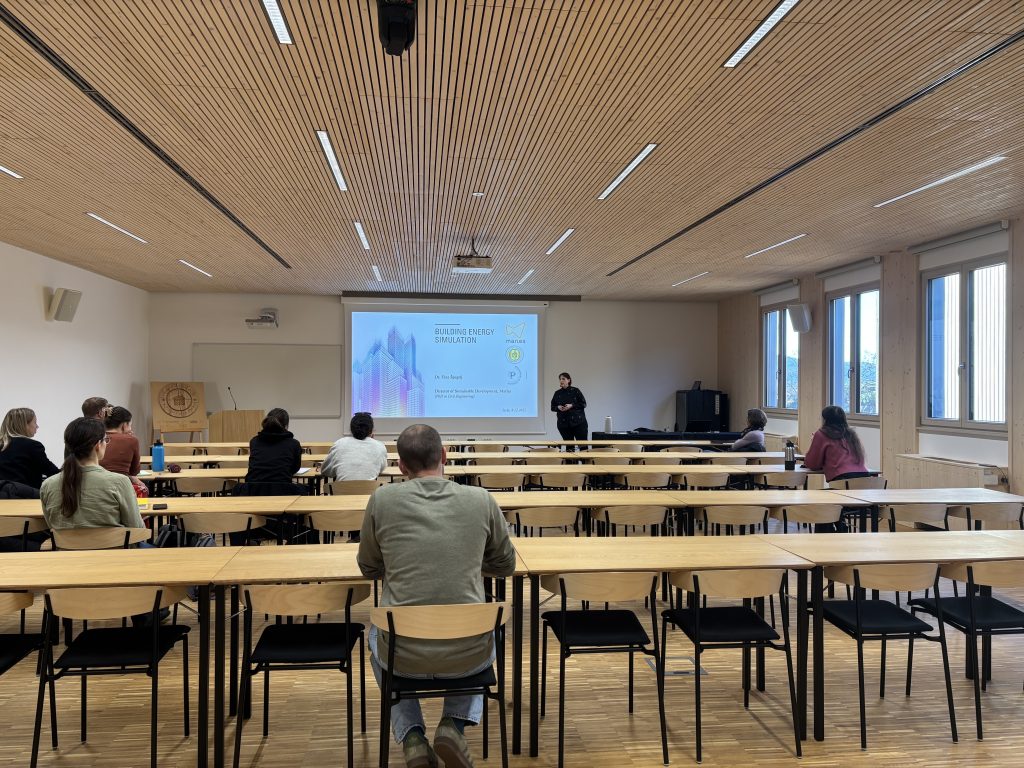
December 10, 2025

In June 2022, InnoRenew CoE and the University of Primorska, a member of the Green Building Council (GBC) Slovenia, hosted a GBC Slovenia expert meeting, “Sustainable Building with Wood and Self-Sustainability: Demonstration of a Restorative Built Environment.”
GBC Slovenia works to enhance sustainable construction, development and real estate management by finding and suggesting ways and solutions that encourage and create buildings and structures managed according to sustainable development criteria. One of the best ways to achieve this goal is to establish a dialogue between the research, education and business spheres. Knowledge transfer and communication within the interdisciplinary process of creating buildings and infrastructure is key to achieving sustainable construction goals.
InnoRenew CoE conducts research on renewable materials and sustainable construction and aims to transfer scientific knowledge into industrial practice. The research institute was established in 2017, and its office building, completed in 2022, was designed and built according to Restorative Environmental and Ergonomic Design (REED) principles.
The GBC Slovenia expert meeting held at InnoRenew CoE combined the two organization’s missions into the conference theme. After the opening address by the President of GBC Slovenia, Dr. Iztok Kamensky, presentations by representatives of industry, research and academia followed.
Janez Mejavšek from Penetron d.o.o. presented crystallization technologies in the role of foundations for wooden structures. The crystallization process permanently reduces the water permeability of concrete while at the same time allowing for its increased autogenous healing ability for cracks up to a half of a millimeter wide. Crystallizing materials can be used as coatings, rehabilitation mortars or additives to fresh concrete and swelling strips used for joint sealing, breaking concrete or punching.
Dean Lipovac, InnoRenew CoE and University of Primorska researcher, presented the built environment’s impact on people, focusing on the role of wood. He highlighted the impact of nature and natural elements on people’s well-being and health. In the built environment, these elements can be brought by looking at nature, photographs and paintings incorporating elements of nature, natural light and indoor plants. In this context, the presence of wood in the built environment can have a positive impact on users’ well-being and health.
In the presentation “How to achieve color harmony in rooms,” Simona Sojar from JUB d.o.o. presented a range of quality wood coatings and highlighted the importance of choosing colors that create perfect color harmony in a room. The impact of colors on the comfort of living was highlighted, as well as the optimal choice of colors according to the room’s context and size, light and the psychological effect of the shades. Paint solutions for natural indoor humidity control, interior coatings to tackle sensitivities and allergies and interior paints that bind harmful formaldehyde were also presented. The presentation included a demonstration, in collaboration with InnoRenew CoE researchers, for measuring a person’s physiological response when interacting with different color shades.
Dr. Nejc Šarabon and Jure Žitnik from InnoRenew CoE and the University of Primorska addressed the development and measurement for optimal furniture ergonomics, which included a demonstration of chairs and tables with different levels of ergonomics. As part of their research, the two have successfully patented several solutions for optimal ergonomic furniture and are now looking for industrial partners to bring these solutions to the market.
Dr. Anna Sandak presented the newly acquired ERC research project “Bioinspired living skin for architecture (ARCHI-SKIN).” The ARCHI-SKIN project aims to develop a protective bio-coating made from engineered living materials. The basic idea is to create a bioactive protective coating system that works in harmony with nature and exploits the synergy of living fungal cells, natural ingredients and bioinspired material design concepts. Dr. Sandak and her team will develop a self-healing biofilm that protects the surfaces of biomaterials, concrete, plastics and metals, among others.
Anamari Hostnik and Darja Zore from JUB d.o.o. presented environmentally and user-friendly wood coatings. In their lecture, they highlighted the importance of coatings that protect wood from mechanical stresses and weathering effects such as UV rays, sunlight and moisture. Wood coatings can also protect against biological insects such as fungi, bacteria, molds and other insects. At the same time, wood coatings are used to restore the aesthetic appearance of wood, cover defects with decorative staining or protect lower-quality wood to prolong its life.
At the end of the meeting, Dr. Iztok Šušteršič from InnoRenew CoE and the University of Primorska presented the InnoRenew CoE building’s construction process and led the tour of the institute, including its laboratories.
Information about GBC Slovenia’s events is published on the association’s website. Members of IZS and ZAPS can obtain credits for continuing professional training by attending GBC professional meetings.
Dr. Igor Gavrić, researcher at InnoRenew CoE